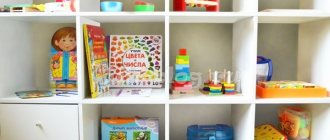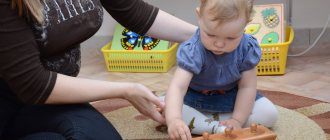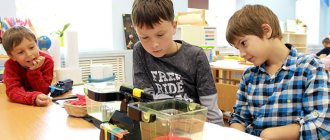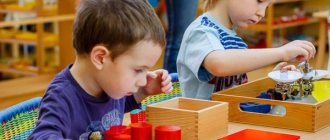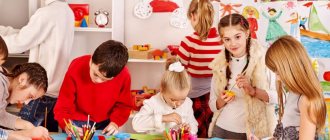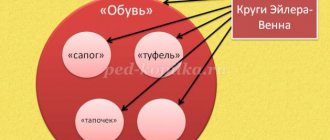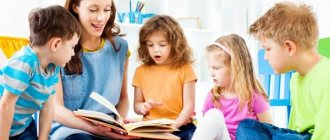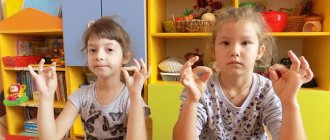What is the essence of the Montessori method?
Montessori education is taught under the motto: “Help me do it myself!” It is believed that if you place a child in a developmental environment and give him freedom of action, he will be happy to explore the world on his own.
Maria Montessori, teacher
Maria Montessori
A child can only reveal himself to us, freely implementing his natural construction plan.
Children choose for themselves what and when to do. The adult’s task is not to interfere, not to criticize, not to praise or compare the child with others. But only show how to use the materials, observe and help if necessary.
“The louder you whistle, the higher I will rise.” How the path of a woman of the era began
Photo from the website of the Russian Montessori School named after.
St. George Maria Montessori was born in Italy in 1870. Her father was in charge of finance at a state tobacco factory and adhered to traditional views. Mother came from the oldest Italian family of Stoppani, which was famous for its prominent scientists. It was she who noticed that young Maria was distinguished by her lively mind and determination. The girl loved mathematics so much that she even took textbooks to the theater. In the semi-darkness of the hall, she was on her knees solving equations and problems.
19th century Italy did not provide educational opportunities for women. The lot of ladies is farming, raising children and charity. Maria, on the contrary, has been involved in science since childhood and dreamed of becoming an engineer. At the age of 13, she broke the stereotype of those years and entered a technical school for boys. Good grades helped her enter the ranks of students at the Technical Institute. Leonardo da Vinci. When the moment of graduation approached, the future student realized: her calling was to become a doctor.
Even in her youth, Maria Montessori first thought about suppressing the student’s personality. The rigid framework of conventions did not allow children to reach their potential and ruined their talents.
She still managed to enroll in the natural sciences course at Sapienza, one of the oldest universities in the world. But the boys were offended by the idea that a young girl would study with them. Dissatisfied classmates constantly tried to “put her in her place,” snorting and laughing contemptuously.
She could only go to lectures accompanied by a man, and sit down only when all the male students had taken their seats. It reached the point of absurdity: a woman examining a naked body is a scandal! Maria had to stay after class and explore human anatomy herself.
What are sensitive periods
Maria Montessori considered the ages from 0 to 6 years to be the most important in a person's life. She identified six sensitive periods favorable for the formation of certain skills. If you start learning earlier or later, the child will be bored or difficult.
From 0 to 3 years: the period of perception of order
It is easiest to teach a child to be clean and to pick up after themselves before the age of 3. In the Montessori system, order is key. Children are involved in cleaning from an early age; they are shown how to lay out things, wipe off dust, and wash dishes. For work, children are provided with special equipment: comfortable brushes and dustpans, a small mop and a broom.
From 0 to 5.5 years: period of sensory development
The child explores the world around him through sensations, sounds and smells. He develops ideas about shape, color, size.
From 0 to 6 years: period of speech development
Each child’s speech develops individually, and if the baby cannot speak at 2 years old, it’s okay. He still has some time left. And special cards, books and visual materials can help.
From 1 year to 4 years: period of development of movements and actions
The child explores the capabilities of his body, develops coordination and strengthens muscles. To do this, he needs a well-equipped children's playground with slides, swings and wall bars.
From 1.5 to 5.5 years: period of perception of small objects
To develop fine motor skills in the Montessori system, it is suggested to perform the simplest actions: string beads on laces, rearrange beans or peas, assemble puzzles.
From 2.5 to 6 years: period of development of social skills
The child gradually learns to live in society: to say hello, to be polite, to be attentive to the needs of other people, to help.
Hygiene
Much attention in Montessori pedagogy is paid to hygiene. This is due to the fact that “Children’s Houses” (kindergarten for residents of apartment buildings) were opened, although in rebuilt, but in the poorest areas of Rome, where the low strata of society lived, crime, debauchery and violence reigned, and in an apartment they could live up to 20-30 people and there was water only a few hours a day. In his main book, “My Method,” Montessori describes these areas at length, but we will limit ourselves to just one phrase:
“Where in the dark no one risks going out without a weapon.”
In such an area, after some “renovation”, the first “Children’s Home” opened. When organizing it, the issue of hygiene became a big problem. Therefore, the first and main rule of this institution was:
“Mothers are obliged to send their children to the orphanage clean.”
Thus, due to social problems, one of the main provisions of Montessori pedagogy appeared.
From the first visit to kindergarten, a child learns to wash his hands and clean his nails, clean up after himself, etc. All this leads to the fact that the child monitors his appearance, actions in every possible way and tries to behave carefully.
How is the development environment organized according to the Montessori method?
In the Montessori system, children are conventionally divided into age categories: from 0 to 3, from 3 to 6, from 6 to 9 and from 9 to 12 years. As a rule, children from 2 years old are involved in classes. And in the group, children of different ages from the same category study at the same time - for example, three-year-olds comprehend the world side by side with five- and six-year-olds. The youngest follow the elders, and the “adults,” by helping others, develop leadership skills and learn to care for the weak.
Rooms in kindergartens and Montessori schools are divided into several zones filled with educational toys, materials and aids.
Sensory education zone
It contains materials for the development of vision, smell, hearing, taste and tactile sensations. Children play with noise instruments, put together figures, touch all kinds of surfaces, get acquainted with smells, and guess what fruit they just ate.
Practical life zone
Children learn basic everyday and social skills: caring for themselves and the environment, etiquette, and rules of communication. They clean clothes and shoes, cook food, water flowers and clean using real tools.
Math zone
Acquaintance with numbers and mathematical operations occurs with the help of toys that develop logic, counting skills, the ability to compare, measure and organize. Gradually, the child goes from basic actions to solving quite complex problems.
Speech development zone
The child expands his vocabulary, develops phonemic awareness, gradually learns to read, and masters writing.
Space Zone (Natural Sciences)
Here the child gets an idea of the world around him: geography, history, botany, zoology, natural sciences.
Montessori method - for which children is this approach suitable?
Surprisingly, we often meet parents who are convinced that Montessori teaching methods are only suitable for gifted and “naturally” motivated children. Parents feel that if their son or daughter is not forced to study, they will simply lie on the couch all day.
In fact, it is always worth remembering that children’s curiosity and desire to explore the world are an innate quality of absolutely any child. The described passivity is most often caused by external factors: an unsuitable environment and an incorrectly organized daily routine, incorrect behavior of adults, and poor health of the child.
Despite the fact that all Montessori techniques involve the child’s free choice and almost unlimited movement around the classroom, even the most “uncontrollable” and “difficult” children eventually successfully integrate into the process.
However, if you think that at first it will be difficult for your baby in group classes using the Montessori method or you are worried about some of the child’s health, all branches of our club offer individual lessons so that your baby has additional adult attention for easier adaptation to a new environment.
What are the disadvantages of the Montessori system?
Criticism of the Montessori method comes down to the following points.
- In Montessori groups, children communicate little. Although the elders are expected to help the younger ones, this is where the interaction practically ends. Children perform individual tasks and do not play role-playing and outdoor games together. In the future, they may find it difficult to work in a team.
- Not enough attention is paid to creativity. The Montessori system was originally aimed at teaching practical skills. Therefore, creativity, along with games, was perceived as something distracting from the main tasks.
- It is difficult for a child to adapt to the regular education system. In Montessori groups, children are not given standardized grades. The teacher only marks the completion of the task: whether he did it or not. Transitioning to a regular school with grades, reward stickers, and competitive moments can be stressful for your child. And sitting at a desk, doing uninteresting tasks, can be very difficult.
- You will still have to transfer to a regular school. There are only a few Montessori schools in the world with a full cycle of education, up to 18 years of age. In most cases, everything is limited to kindergarten and the elementary level of education - for children 6–12 years old.
Basic Montessori Methods
To briefly outline the main ideas of the Maria Montessori method, it is important to first explain on what beliefs the approach is based:
1. The child develops following his natural interests and thanks to the experience independently gained on their basis,
2. Only a well-organized environment allows a child to fully realize his development potential,
3. An adult can be a guide and assistant, but cannot become the only full-fledged source of knowledge and skills for the development of a child,
It is these beliefs that determine the style of interaction between children and adults who have chosen the Montessori method for their children.
The approach is distinguished by a specially organized environment (didactic material freely accessible to the child), appropriate to the age of the children; the child’s leading position, his independence and free choice of activities; respectful and attentive attitude of adults to the individual needs of the baby.
Let's briefly formulate the basic principles of the Maria Montessori method:
1. Lack of a classroom system and free movement of the child in the classroom space,
2. The absence of a unified program and compulsory curriculum for all pupils, an individual approach to each child,
3. Classes using the M. Montessori method are held in a group of different ages,
4. Any Montessori session requires a prepared environment, ordered and varied materials for learning,
5. The adult follows the child’s interest, observes the children’s work and is very limited in their independent activities.
Now let's study in more detail the features of the Montessori method and start with what goals a Montessori teacher faces depending on the age of the students.
How to make Montessori toys with your own hands
The peculiarity of the Montessori system is that, in fact, you do not need to buy any special toys. If you don’t have something at home, you can do it yourself or buy it in a store for pennies.
It will take a minimum of time and will not require special skills on the part of parents. And improvised means are suitable as materials.
Insert frames
Such toys will help kids understand what shapes are and what they are. And also learn to quickly distinguish colors, master the concepts of “more and less.”
For production you will need:
- box (you can take it from the candy you’ve eaten);
- a landscape sheet, but a Whatman paper is better;
- multi-colored cardboard.
Cut the box into rectangles. Their size depends on the number of figures that will be placed in the frame. For each rectangle, its own geometric figure is cut out of multi-colored cardboard. The figures in one row should be multi-colored and vary in size. The largest figure comes first, and those below should gradually become smaller. To hold the figures, whatman paper is glued to the back of the box.
Pyramid
The easiest way is to sew such a toy, but in order to do this, the parent must have at least primitive sewing skills. But there are a lot of benefits from this toy. She will teach the baby to distinguish colors, sizes, tactile sensations and more. All you need to do is use different fabrics and fillers.
To work you will need:
- fabric of different colors and, if possible, texture;
- Velcro tape;
- materials for stuffing - cereals, foam rubber, padding polyester, pebbles, in general, anything.
The fabric needs to be cut into paired squares of different sizes - from 5 to 12 cm. Take a pair of squares. Velcro is sewn onto one of the flaps of fabric, and the part that should stick is sewn onto the second. The squares are sewn together (from the wrong side). Next, the material needs to be turned out and filled with filler. And repeat this until all the pads are filled.
But it is important that the pyramid does not turn over; the lower layers are filled with heavier materials.
Colored hedgehogs
Hedgehogs are one of the most popular characters in children's fairy tales, so a child will be happy to play in such company.
To make these toys we will need:
- sheets of multi-colored cardboard;
- multi-colored clothespins.
You need to cut out two identical hedgehog shapes from cardboard. The easiest way to do this is to fold the cardboard in half and then start cutting. Next, you need to glue the figures together, drawing eyes, a mouth, and a nose. When the workpiece is ready, all that remains is to invite the child to give the hedgehog needles by attaching multi-colored clothespins to it.
Laces
Lacing games are the best way to develop fine motor skills in a child’s hands. You can buy them in a store, but the price isn’t great, so it’s much cheaper to make them at home.
Moreover, everyone probably has the materials needed for this at home:
- wooden base, an alternative to which can be thick cardboard or plywood;
- holes can be made with a hole punch or knife;
- buttons glued to the base;
- lace.
The set of materials depends on what is at hand. Sometimes you don’t even need to drill anything, just glue buttons to the board and show your child how to wrap the laces around them. It all depends on your imagination.
Soft balls
The essence of the game is that the baby is given four fur balls, which must be pushed through the tube one at a time so that the last one pushes the first one out.
To make such a toy, we need:
- thick cardboard;
- bushing (balls will pass through it);
- shampoo bottle (this will be the leg that will hold the sleeve);
- skeins of multi-colored yarn acting as balls.
You need to make two cuts in the shampoo bottle through which the sleeve will go. The sleeve itself should be exactly long enough for three balls stacked in a row to pass through it. You can secure the structure with tape and decorate it with colored paper.
Materials and toys
Didactic materials and Montessori - toys for kindergarten are selected specifically, each item has meaning. The purpose of use is to develop the child’s senses: touch, smell, taste. Children learn to distinguish the color, shape, weight, structure of an object, and sounds produced. Special materials are selected for each area of the senses. The teacher can demonstrate how to play, build, and match objects while observing the child’s actions. Noticing that the child is making progress, the adult shows more complex compositions of materials and toys, offering to repeat his actions. At the same time, the adult should show and offer unobtrusively, giving priority to the independence of children.
M. Montessori classified basic materials - toys:
- Materials for distinguishing sizes (pink tower, brown ladder, red rods, blocks with cylinders - liners, colored cylinders;
- Materials for distinguishing colors (color plates);
- Materials for distinguishing shapes (geometric chest of drawers, biological chest of drawers, constructive triangles, geometric solids);
- Materials for distinguishing structural surfaces (a keyboard board with smooth and rough surfaces, a board for feeling large and small parts, a box with pieces of fabric);
- Materials for distinguishing weight (heavy and light signs, figures);
- Materials for distinguishing between noises and sounds (noisy boxes, bells);
- Materials for distinguishing odors (boxes with the smells of cocoa, coffee, cinnamon, etc.);
- Materials for distinguishing taste qualities (flavor jars with salty, sweet, sour water, etc.);
- Materials for the perception of temperature differences (metal jugs filled with water of different temperatures are used).
In addition to sensitive “sensory” materials, mathematical sets are used in the children’s group room, developing counting skills and creating in children an understanding of logical arithmetic, quantitative space, and the decimal counting system. They are closely related to the previous group and often have the same size and shape.
Mathematical materials - toys - are:
- Number bars with signs,
- Numbers cut from rough paper
- Boxes with wooden spindles,
- Numbers and circles cut from wood,
- Trays with gold beads,
- Number cards and boards and others.
Also for children of middle and preschool age it is proposed to use combinations of beads and cards, towers of multi-colored beads, chains of 10, 100 and 1000 beads, boxes with number rows of objects.
For the speech development zone, M. Montessori developed a number of toys and aids:
- Metal figures – inserts for tracing with a pencil,
- Rough paper letters
- Boxes with movable letters.
In Montessori kindergarten it is difficult to find ordinary dolls, horses, cars. All toys and materials are selected for a specific purpose and have a special purpose.
Modern manufacturers of children's goods have developed various sets of educational toys based on the experience and suggestions of M. Montessori. They are easy to find in children's stores or ordered online. But toys and Montessori aids can be made with your own hands, for example:
- Bright cardboard box with a hole for pushing balls,
- An insert from a candy box with holes or ice cube trays into which you can place nuts or large beads,
- Bags made of various fabrics with fillings (buckwheat, peas, beans, etc.),
- Drawing stamps cut from potato tubers and others.
Manuals on the Montessori method contain a detailed description of making educational toys from scrap materials. There are also many interesting ideas for using household items for games that parents have no idea about.
Five principles proposed by M. Montessori
- The child is active . The adult acts as an assistant, his role is secondary. The child needs to be interested, and he will develop himself. Classes take place in a specially prepared environment.
- The child is his own teacher . He has full freedom of action and choice. Children teach each other according to the principle from older to younger, which allows them to learn to care for others;
- Child's independence in decision making;
- Full self-development is a consequence of freedom in actions, thinking, and feelings. A child becomes himself when we follow the instructions of nature, and do not go against them.
- Respect for children – absence of prohibitions, criticism and instructions. A child has the right to make mistakes and figure everything out on his own.
In order to understand what the Montessori method is, it is enough to follow its theory and agree with the belief that any child is a normal person, capable of discovering himself in active work
Lessons in Silence
As we have already said, in a Montessori environment there are no heavy or fixed desks. Instead, lightweight desks and chairs are offered that move easily and make sound. But this is not done for the sake of creating noise, but just the opposite. A Montessori garden is a quiet place where every child is enthusiastically busy with their work. And when a child, getting up from the table, makes noise, it distracts other children, they pay attention to the silence breaker. The child who made the noise finds such attention unpleasant, and next time he tries to do it as quietly as possible so as not to disturb other children. All this develops not only grace and skill in getting up from the table unnoticed (and also walking quietly), but most importantly it makes you aware of the value of other people’s feelings, which are so easy to interfere with and disrupt their concentration.
In addition, M. Montessori developed special silence lessons, where children learn to control their behavior and be more organized. For example, one of the silence lessons goes like this: the teacher leaves the children alone, and she goes into another room and from there, in a barely audible whisper, calls one of the children by name. The child’s task is to hear his name and get up very quietly, without making noise, and go to the teacher in another room.

